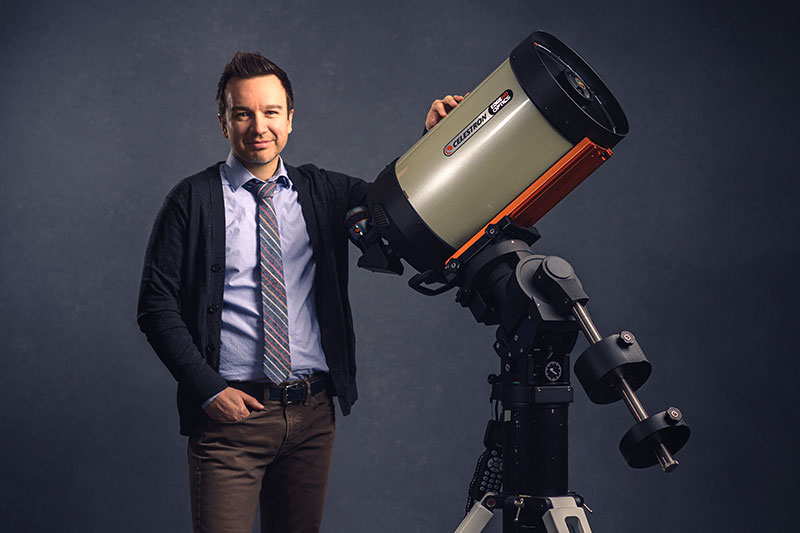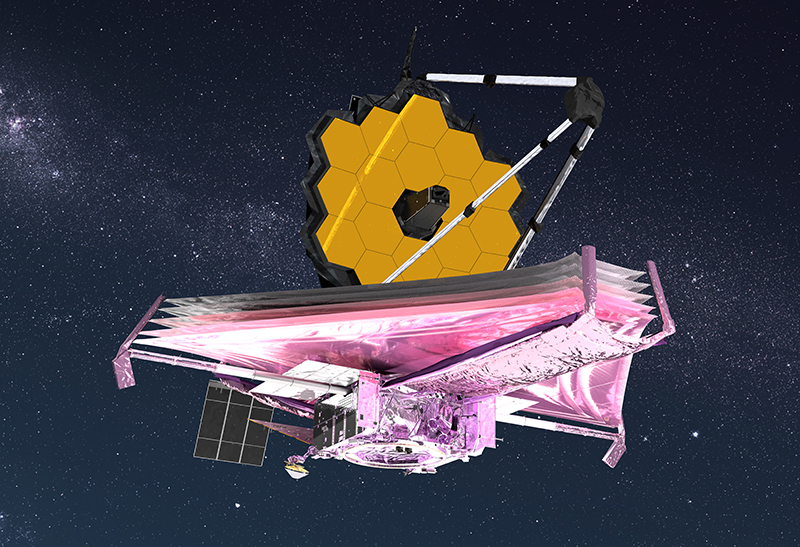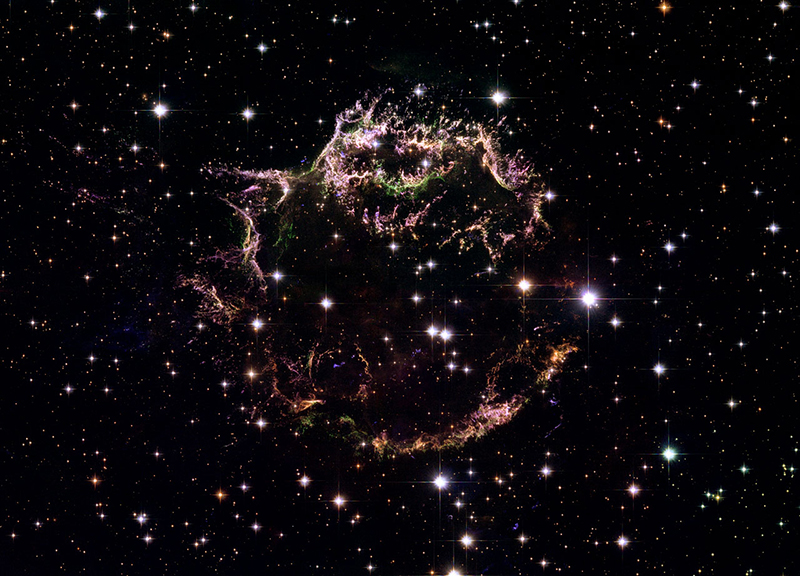
Danny Milisavljevic, assistant professor of physics and astronomy in Purdue University's College of Science, is leading a research team using the world's most powerful telescope, launching later this month. (Purdue University photo/Rebecca McElhoe)
WEST LAFAYETTE, Ind. — Star birth, star death, exoplanets, galaxies and a window that looks back to the universe 13.1 billion years ago: That's what the James Webb Space Telescope (JWST) delivered when it released its first handful of scientific images on Tuesday (July 12).
As he has from the beginning, astronomer Danny Milisavljevic watched with fellow astronomers, witnessing the universe unfold before his eyes.
"These images were incredible," Milisavljevic said. "JWST just launched a new era of space exploration. The images pushed the envelope of my understanding – of my ability to even explain what I was seeing. These images reveal all sorts of structures that we have never seen before and led me to ask all sorts of questions that I had never even thought to ask."
An assistant professor of physics and astronomy in Purdue University's College of Science, Milisavljevic (pronounced mili-sahv-la-vich) leads a team of collaborators that will study images like the ones JWST released for insights into the life cycles of stars, galaxies and the universe itself. JWST is the most powerful space telescope ever launched and the successor to the Hubble Space Telescope, which allowed humans to see farther into space and deeper into time. After launching in late December and reaching its orbit in January, the JWST has been calibrating its instruments and preparing for its role as humanity's longest-sighted eyes.
Milisavljevic emphasizes that the telescope is not just larger or more powerful than the Hubble – though it is those things – but it also incorporates scientific knowledge learned from the Hubble to look at the stars in an entirely new way.
"The images don't just look better – they're different," Milisavljevic said. "It's not just better resolution, but JWST is looking at infrared emissions sensitive to a variety of different elements and molecules that Hubble cannot access. It's exciting to look at the promise of the JWST coming true."
Before JWST, the Hubble Space Telescope allowed humans to see farther into space and deeper into time. The JWST is bigger, is more complex and orbits farther from the Earth than Hubble, allowing it unprecedented opportunities for interstellar sleuthing. JWST looks even farther into space and time, and with an unprecedented range of wavelengths and strength of definition. The knowledge it uncovers may help scientists take the next small steps out into the universe — and discern where humans want to go next and why.
Milisavljevic leads a team of nearly 40 scientists and researchers from more than 30 institutions — including Harvard, Princeton and Johns Hopkins universities, as well as Los Alamos National Laboratory and the SETI Institute — in studying Cassiopeia A, one of the more puzzling objects in the galaxy. Cassiopeia A comprises the remnants of a supernova explosion and has at its heart a neutron star that doesn't behave the way scientists think neutron stars ought to behave.
"JWST is going to allow us to look at stellar objects at wavelengths and resolutions we've never been able to use before," Milisavljevic said. "Supernova remnants are leftover explosions — that's what we'll be studying. We'll be able to study what type of star was there before the explosion, the physics of the explosion, the type of dust it generated and what made it all happen. Supernova explosions make all the materials for life — the oxygen we breathe, the iron in our blood."
Bigger, farther, better
 An artist's rendering of the James Webb Space Telescope, the Hubble's successor. It will orbit Earth four times farther out than the moon and employ an unprecedented range of wavelengths and strength of definition (NASA GSFC/CIL illustration/Adriana Manrique Gutierrez)
An artist's rendering of the James Webb Space Telescope, the Hubble's successor. It will orbit Earth four times farther out than the moon and employ an unprecedented range of wavelengths and strength of definition (NASA GSFC/CIL illustration/Adriana Manrique Gutierrez) JWST is larger than Hubble. Its primary mirror is about 20 feet across, while Hubble's is just 8 feet across. Hubble's telescopes looked primarily at objects in the ultraviolet, visual and near-infrared wavelengths. But many objects that astronomers want to see and study — like the universe's oldest galaxies, exoplanets and stars — are hidden behind swaths of dust. Infrared wavelengths allow scientists to get a clearer view than visual wavelengths of light could give them.
Hubble rode into space aboard the shuttle Discovery. Hubble's orbit is about 350 miles up. JWST orbits Earth from nearly a million miles away — four times farther away than the moon and 2,500 times farther out than Hubble.
JWST's home is a special spot in space called L2, or the second Lagrange Point. It's a place where, thanks to the orbital dynamics of Earth, the moon and sun, it will stay in a fixed position with respect to Earth — always keeping Earth between itself and the sun. This is an ideal location from which to observe the universe because the satellite won't have to use too much of its fuel in adjustments to its orbit, a vital consideration since it will be so far away from its home planet.
Eyes on the sky
 Cassiopeia A is a supernova remnant about 11,000 light-years away. Insights into Cassiopeia A will help scientists understand more about how stars live and die, how metals are distributed throughout galaxies, and potentially even probe the origin of life itself. (NASA, ESA, and the Hubble Heritage (STScI/AURA)-ESA/Hubble Collaboration) photo/Robert A. Fesen (Dartmouth College) and James Long (ESA/Hubble))
Cassiopeia A is a supernova remnant about 11,000 light-years away. Insights into Cassiopeia A will help scientists understand more about how stars live and die, how metals are distributed throughout galaxies, and potentially even probe the origin of life itself. (NASA, ESA, and the Hubble Heritage (STScI/AURA)-ESA/Hubble Collaboration) photo/Robert A. Fesen (Dartmouth College) and James Long (ESA/Hubble)) Milisavljevic is collaborating on several JWST projects and is serving as principal investigator in looking at Cassiopeia A, a supernova remnant about 11,000 light-years away.
The project will take place during the first year of JWST's research, beginning after it reaches L2. JWST will use infrared imaging and spectroscopy to examine Cassiopeia A. Scientists want to study how it formed and look at the neutron star, an X-ray source in the heart of the cloud of star-stuff.
"This proposal, like the telescope itself, has been years in the making," Milisavljevic said. "Proposals usually take a couple of weeks; this one took years. There are a lot of people involved, with a lot of overlapping and potentially competitive research interests. I was able to convince them that united as an ultimate dream team of investigators, we are stronger than our individual parts."
Supernovae resulting from collapsing stars are among the most influential phenomena in any galaxy when it comes to building stars and planetary systems. But they are also not at all well understood. Insights into how Cassiopeia A formed will help scientists understand more about how stars live and die, how metals are distributed throughout galaxies, and potentially even probe the origin of life itself.






